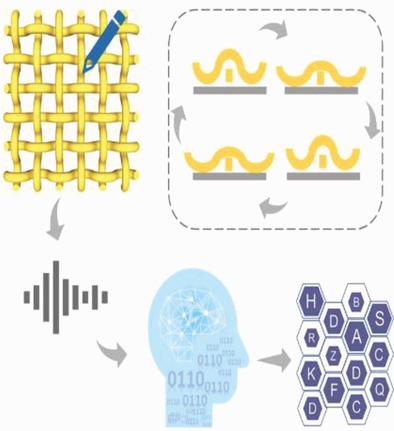当前位置:
X-MOL 学术
›
Adv. Mater. Technol.
›
论文详情
Our official English website, www.x-mol.net, welcomes your
feedback! (Note: you will need to create a separate account there.)
Triboelectric Nanogenerator Based Smart Electronics via Machine Learning
Advanced Materials Technologies ( IF 6.4 ) Pub Date : 2020-01-09 , DOI: 10.1002/admt.201900921 Xianglin Ji 1, 2 , Tingkai Zhao 1 , Xin Zhao 1, 3 , Xufei Lu 1 , Tiehu Li 1
Advanced Materials Technologies ( IF 6.4 ) Pub Date : 2020-01-09 , DOI: 10.1002/admt.201900921 Xianglin Ji 1, 2 , Tingkai Zhao 1 , Xin Zhao 1, 3 , Xufei Lu 1 , Tiehu Li 1
Affiliation

|
With the development of artificial intelligence, it is urgent to empower traditional electronics with the ability to “think,” to “analyze,” and to “advise.” Here, a new product concept namely triboelectric nanogenerator (TENG) based smart electronics via the automatic machine learning data analysis algorithm is proposed. In this work, a simple water processing technique is used to fabricate porous polydimethylsiloxane, together with the weaving copper mesh, forming a high sensitivity flexible TENG. The as‐prepared TENG presents high sensitivity for the voice signal and handwriting signal detection with ≈0.2 V amplitude in the common talking and writing condition. Three words' pronunciation are recorded and the ensemble method is used as the machine learning model for the voice signal recognition with a recognition accuracy of 93.3%. To further demonstrate the possibility of applying machine learning algorithm for automatic analysis and recognition, larger database is analyzed. Twenty‐six letters' handwriting signals with total 520 samples are collected and a letter fingerprint library is established for further analysis. Hierarchical clustering and similarity matrix are used to study the intrinsic relationship between letters. “Medium Gaussian support vector machine” is used as machine learning model for the 26‐letter fingerprint identification with recognition accuracy of 93.5%.
中文翻译:

通过机器学习的基于摩擦电纳米发电机的智能电子
随着人工智能的发展,迫切需要使传统电子产品具有“思考”,“分析”和“建议”的能力。在此,通过自动机器学习数据分析算法,提出了基于摩擦电纳米发电机(TENG)的智能电子产品新概念。在这项工作中,使用一种简单的水处理技术来制造多孔聚二甲基硅氧烷以及编织铜网,从而形成高灵敏度的柔性TENG。所准备的TENG在常见的通话和书写条件下,对语音信号和手写信号的检测具有高灵敏度,振幅约为0.2V。记录三个单词的发音,并将集成方法用作语音信号识别的机器学习模型,识别精度为93.3%。为了进一步证明将机器学习算法应用于自动分析和识别的可能性,分析了较大的数据库。收集了总共520个样本的26个字母的手写信号,并建立了一个字母指纹库以供进一步分析。层次聚类和相似度矩阵用于研究字母之间的内在关系。“中高斯支持向量机”被用作26个字母指纹识别的机器学习模型,识别精度为93.5%。层次聚类和相似度矩阵用于研究字母之间的内在关系。“中高斯支持向量机”用作26个字母指纹识别的机器学习模型,识别精度为93.5%。层次聚类和相似度矩阵用于研究字母之间的内在关系。“中高斯支持向量机”用作26个字母指纹识别的机器学习模型,识别精度为93.5%。
更新日期:2020-02-10
中文翻译:

通过机器学习的基于摩擦电纳米发电机的智能电子
随着人工智能的发展,迫切需要使传统电子产品具有“思考”,“分析”和“建议”的能力。在此,通过自动机器学习数据分析算法,提出了基于摩擦电纳米发电机(TENG)的智能电子产品新概念。在这项工作中,使用一种简单的水处理技术来制造多孔聚二甲基硅氧烷以及编织铜网,从而形成高灵敏度的柔性TENG。所准备的TENG在常见的通话和书写条件下,对语音信号和手写信号的检测具有高灵敏度,振幅约为0.2V。记录三个单词的发音,并将集成方法用作语音信号识别的机器学习模型,识别精度为93.3%。为了进一步证明将机器学习算法应用于自动分析和识别的可能性,分析了较大的数据库。收集了总共520个样本的26个字母的手写信号,并建立了一个字母指纹库以供进一步分析。层次聚类和相似度矩阵用于研究字母之间的内在关系。“中高斯支持向量机”被用作26个字母指纹识别的机器学习模型,识别精度为93.5%。层次聚类和相似度矩阵用于研究字母之间的内在关系。“中高斯支持向量机”用作26个字母指纹识别的机器学习模型,识别精度为93.5%。层次聚类和相似度矩阵用于研究字母之间的内在关系。“中高斯支持向量机”用作26个字母指纹识别的机器学习模型,识别精度为93.5%。











































 京公网安备 11010802027423号
京公网安备 11010802027423号